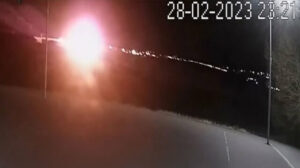The Ghent University Report on fireball simulations conducted by experts representing the families of victims in the Tempi tragedy – as executed on behalf of EODASAAM – was sent to Ellinika Hoaxes by Dr. G. Maragos, who co-authored it with Professor Bart Merci, following communication with Kostas Lakafosis.
Reading through the Report reveals that the two academics neither rejected nor endorsed any of the proposed fireball origin scenarios, which makes their protest justified over how misleadingly their work was used in the EODASAAM findings.
Specifically, the EODASAAM conclusion stated the following, prompting backlash from both Ghent University and the University of Pisa:
“The CFD mathematical model calculations show that approximately 2,500 kg of generic hydrocarbon fuel would be required to simulate the three distinct phases (1,000, 1,200, and 300 kg respectively) of the explosion, fireball, and secondary fires recorded in three videos capturing the incident from three different angles.”
It also stated:
“Various simulations were executed using different release and dispersion geometries, as well as varying AIT (auto-ignition temperature) values, starting from a realistic 450°C and lowering to 350°C, as UGent suggested to simulate the possibility of pilot ignition—and even down to 250°C, which is an unrealistically low value representative of less safe mineral oils.”
The results of these tests rule out the possibility that PDMS silicone oils could create such a large fireball and fire, as the only plausible outcome is a small localized ignition that would not spread to the rest of the material, even if the total amount of silicone oil were sprayed and dispersed unrealistically across the entire area.
The Report and the Findings
Read the Ghent University Report here:
Closing
“The Report fully confirms the @ellinikahoaxes article and our correspondence,” stated the site on X.
It’s worth noting that researcher Maragos from Ghent University, in communication with Ellinika Hoaxes on April 4, 2025, had stated the following:
“There is no justification for the amount or type of fuel stated in the EODASAAM report. For example, one can achieve a comparable fireball size in hundreds of different ways depending on the data you feed into the models. The same fireball size can be achieved with a significantly smaller fuel quantity than the one referenced in the report, again depending on the data input. Silicone oil droplets can ignite provided there is a sufficiently high heat source—what surprised me was that the opposite was claimed in the Report.”
In a more recent post, fact-checker Elena Vatala from Ellinika Hoaxes stated:
The reference to scenario Case04_05b by the researcher pertains precisely to the burning of silicone oils as the cause of the fireball created right after the collision of the trains in Tempi – a scenario adopted by most expert assessments regarding the February 28, 2023 tragedy. In short, the academics imply that a small change in the simulation parameters leaves room for the silicone oil combustion theory…
Read the relevant excerpt from the Report:
The Ghent Report on Tempi that Exposes EODASAAM: “Silicone oils do burn”
As is known, EODASAAM issued its findings on the train collision on the eve of the second anniversary of the tragedy, adopting – while calling for further investigation – the scenario put forward by the technical advisors of some of the victims’ families, with leading figures being Kostas Lakafosis and Vasilis Kokotsakis. The latter, even disregarding the forensic reports, went as far as to claim that 28 of the 57 victims did not die from the crash itself but burned to death due to a fire caused by a “possible illegal flammable cargo,” as noted in the EODASAAM findings.
It is important to note that by the time EODASAAM issued its findings, the videos from the freight train had already been made public, showing no cargo other than what had been declared to Hellenic Train.
Ask me anything
Explore related questions





